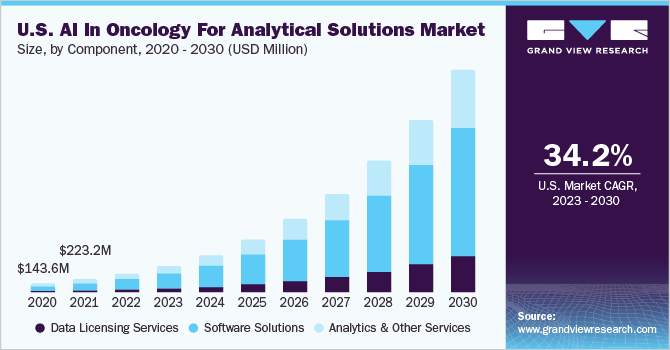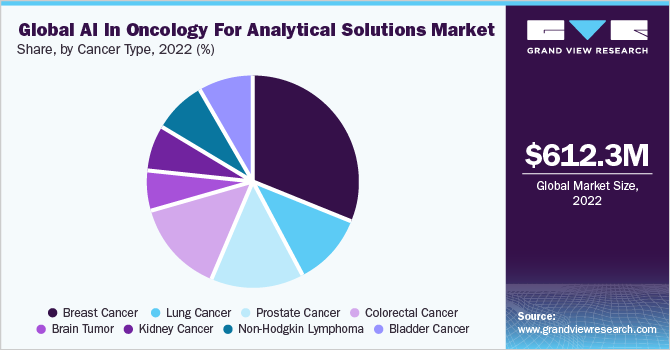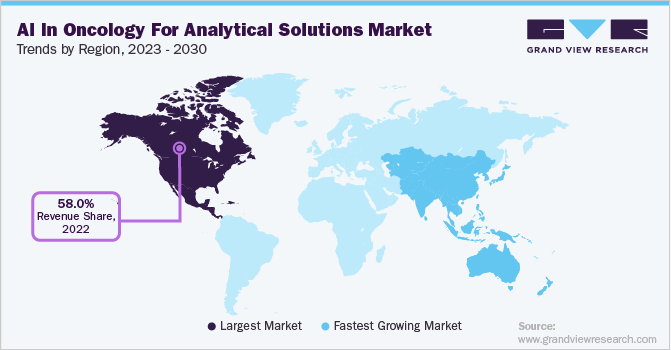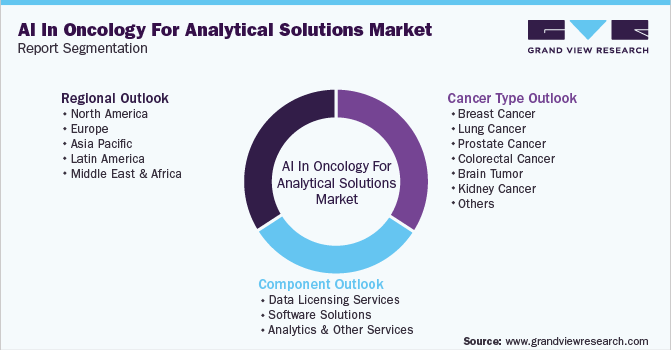- Home
- »
- Healthcare IT
- »
-
AI In Oncology For Analytical Solutions Market Size Report, 2030GVR Report cover
![AI In Oncology For Analytical Solutions Market Size, Share & Trends Report]()
AI In Oncology For Analytical Solutions Market (2023 - 2030) Size, Share & Trends Analysis Report By Cancer Type, By Component, By Region, And Segment Forecasts
- Report ID: GVR-4-68040-043-5
- Number of Report Pages: 150
- Format: PDF
- Historical Range: 2018 - 2021
- Forecast Period: 2023 - 2030
- Industry: Healthcare
- Report Summary
- Table of Contents
- Segmentation
- Methodology
- Download FREE Sample
-
Download Sample Report
AI In Oncology For Analytical Solutions Market Summary
The global AI in oncology for analytical solutions market size was valued at USD 612.3 million in 2022 and is projected to reach USD 7.40 billion by 2030, growing at a CAGR of 35.5% from 2023 to 2030. The market is being driven by the increasing prevalence of cancer.
Key Market Trends & Insights
- The North America dominated the market in 2022 with a share of over 58.0%.
- Based on cancer type, breast cancer dominated with a share of 30.8% in 2022.
- Based on component, the software solution segment accounted for the highest market share of 57.1% in 2022.
Market Size & Forecast
- 2022 Market Size: USD 612.3 Million
- 2030 Projected Market Size: USD 7.40 Billion
- CAGR (2023 to 2030): 35.5%
- North America: Largest market in 2022
- Asia Pacific: Fastest growing market
This is due to the fact that there is a rapid growth in the number of cases globally. It is a leading cause of death globally, and in 2020 alone, it resulted in approximately 10 million deaths, which is almost one-sixth of all deaths according to WHO. World health organization further stated one-third of cancer-related deaths can be attributed to factors such as tobacco use, high body mass index, alcohol consumption, inadequate fruit and vegetable consumption, and lack of physical activity. In low- and middle-income countries, cancer-causing infections, such as human papillomavirus (HPV) and hepatitis, account for approximately 30% of all cases. Due to this, the adoption of Artificial Intelligence (AI) for the accurate diagnosis and treatment of this disease is expected to increase, which will contribute to the growth of the market.
The COVID-19 pandemic has had a mixed impact on the market. On one hand, the pandemic has highlighted the importance of technology in healthcare, including artificial intelligence-powered applications. On the other hand, the pandemic has also disrupted the healthcare system, including cancer care, which has affected the adoption and implementation of AI in oncology. One of the major impacts of the pandemic has been a shift toward telemedicine and remote care. This has led to an increase in the use of AI-powered telemedicine tools for disease diagnosis and treatment planning, as well as remote monitoring of patients. This trend is expected to continue even after the pandemic, as it has demonstrated the potential for artificial intelligence in providing more accessible and efficient care. However, the pandemic has also led to a disruption in cancer care, including delays in diagnosis and treatment due to resource constraints and safety concerns. This has affected the adoption of artificial intelligence in oncology, as it relies on a large amount of data and real-world evidence to be effective. Additionally, the economic impact of the pandemic has led to budget cuts in healthcare, which may affect the investment and development of AI in oncology.
Furthermore, individuals with lung cancer have a higher risk of contracting COVID-19. A report published in December 2022, provides information on deaths recorded in Center for Disease Control and Prevention’s National Vital Statistics System between January 1, 2018, and July 2, 2022, where cancer was listed as the underlying or a contributing cause of death. The data analyzed stated, on an average, about 13,000 cancer-related deaths were reported each week, with this disease listed as the underlying cause in 90% of cases in 2018 and 2019, 88% in 2020, and 87% in 2021. Lockdown restrictions during the pandemic posed significant challenges for patients in terms of diagnosis, treatment, and care. However, modern AI and ML technologies have the potential to enhance the diagnosis, care, and treatment of patients, particularly in such challenging circumstances. Artificial intelligence was utilized to address the backlog of cancer imaging during the pandemic, which reduced the workload on healthcare professionals.
The market is expected to benefit from the use of artificial intelligence due to its ability to facilitate early detection. Early detection is crucial in reducing the number of cancer-related deaths, and artificial intelligence can play a significant role in achieving this. The utilization of AI for screening and diagnosis is expected to drive market growth. AI/ML models can analyze images from radiology and pathology, providing a more precise diagnosis compared to relying solely on a physician's experience. For instance, in 2019, a team of researchers from the National Institutes of Health and Global Good developed an artificial intelligence algorithm capable of analyzing digital images of women's cervix. This algorithm accurately identifies precancerous changes that could potentially lead to cancer.
The growth of the healthcare infrastructure worldwide is also driving the expansion of the market. In July 2021, the Centre for Fourth Industrial Revolution of the World Economic Forum India launched the Fourth Industrial Revolution for Sustainable Transformation (FIRST) of the Cancer Care project, which focuses on utilizing advanced technologies such as artificial intelligence, IoT, and blockchain to provide affordable, accessible, and high-quality care in India. Consequently, the expansion of the healthcare infrastructure is expected to drive market growth throughout the forecast period.
The growth is further fueled by the increased research activities for integrating AI into various cancer therapies. For instance, a research activity in chemotherapy was the CURATE.AI solution developed by the National University of Singapore in June 2022, this solution utilizes clinical data such as drug dosage, medications, and biomarkers to create a personalized digital profile of the patient. This provides tailored chemotherapy dosage recommendations, resulting in improved cancer patient outcomes. The incorporation of AI in oncology has several advantages, including the ability to customize dosages, which reduces side effects, the use of AI models to predict cancer recurrence accurately, and high precision. Consequently, the adoption of such products is expected to increase among the target population, thereby driving market growth.
Cancer Type Insights
The breast cancer dominated with a share of 30.8% in 2022, owing to a growing demand for use of AI to detect, diagnose, and treatment. The early detection and accurate diagnosis through AI-based medical devices and software have the potential to significantly improve patient outcomes. This has led to an increase in the adoption of AI in breast cancer diagnosis, with various artificial intelligence/machine learning-based software solutions offered by various key players. Moreover, there has been a surge in research activities for incorporating AI in breast cancer chemotherapy, personalized medicine, and even predicting the recurrence of the disease. The integration of artificial intelligence in breast cancer treatment can result in reduced side effects, improved treatment outcomes, and enhanced patient experiences.

The bladder cancer segment is anticipated to witness the fastest growth over the forecast period from 2023 to 2030. The segment is expected to grow due to several factors such as the consumption of alcohol, unhealthy diet, tobacco use, and reduced physical activity that increase the risk of cancers. Additionally, the availability of various AI-based models such as clinical, imaging, and combined data models for the diagnosis and treatment of this types of cancer is expected to further drive growth. Various players catering this segments are adopting different strategies, for instance, in June 2022, Paige announced a partnership with Janssen Research & Development, LLC to assess the feasibility of using an H&E-based AI-powered biomarker test to identify specific actionable mutations in the fibroblast growth factor receptor genes in patients with advanced urothelial cancer, commonly referred to as bladder cancer.
Component Insights
In 2022, the software solution segment accounted for the highest share of 57.1% in the market, owing to the emergence of more and more startup companies that offer creative solutions for cancer treatment and accurate cancer prediction. The growth of this segment can be attributed to the rise in the number of major players, including AZRA AI, that provide software solutions to manage and interpret unstructured data and prioritize the patients in need of treatment and follow-up care. The use of such software can increase efficiency, improve workflow, and save time. Additionally, the availability of various applications, such as diagnostic imaging, interventional radiology, and radiation oncology is expected to further drive growth in this segment.
The data licensing services segment is expected to witness the fastest growth over the forecast period from 2023 to 2030. Data licensing allows companies to access and use data for the development and training of artificial intelligence models. With the increasing use of artificial intelligence in healthcare, particularly in oncology, there is a growing demand for high-quality data to train AI algorithms. This data includes medical images, patient records, and other healthcare-related information. Some companies offer data licensing services to provide access to high-quality data. For example, the Cancer Imaging Archive (TCIA) is a publicly accessible database of cancer imaging data that can be used for research purposes.
Regional Insights
North America dominated the market in 2022 with a share of over 58.0%. The growth is attributed to factors such as the presence of digital infrastructure and favorable government policies. The adoption of oncology services in the region is expected to increase due to rising reimbursements offered by the governments. Additionally, the governments in the region are increasing their spending on digital healthcare, which is expected to enhance the IT infrastructure needed to provide AI solutions to patients. AI is expected to save screening time and money for majority of people in, for instance, a study conducted by the Lancet Digital Health stated that if 60% of the US population undergoes screening colonoscopy, using AI for screening could prevent 7,194 cases of colorectal cancer and 2,089 colorectal cancer-related deaths annually, while also savings of USD 290 million per year.

Asia Pacific is projected to witness the fastest growth over the forecast period from 2023 to 2030. This growth can be attributed to several factors such as the increasing elderly population in countries including India and Japan and the growing adoption of digital technologies in hospitals and diagnostic facilities. A recent example of this trend is the introduction of an AI-assisted colorectal screening by Farrer Park Hospital, a healthcare provider based in Singapore, in June 2022. This service uses AI tools to improve the monitoring, detection, screening, and classification of colorectal polyps and cancer. The AI system alerts doctors in real-time about suspected polyps and lesions, helping to improve patient outcomes.
Key Companies & Market Share Insights
The key companies are adopting strategies such as new product launches, acquisitions, mergers, collaborations, and partnerships to maintain a competitive edge. For instance, in August 2022, Medtronic plc launched the GI GeniusTM intelligent endoscopy module in India, which is powered by AI and helps healthcare practitioners detect colorectal cancer by providing improved visualization during colonoscopy. Similarly in September 2021, Cleveland Clinic researchers and Owkin, Inc. announced the launch of a deep-learning model that can predict survival and health outcomes for hepatocellular carcinoma.
In addition, there has been a notable increase in the utilization of AI in radiographic imaging for the early detection and diagnosis of breast cancer in recent years. Regulatory bodies have also approved numerous AI and machine learning (ML) based medical devices for breast cancer diagnosis, which has contributed to the market growth. For example, the FDA has approved nearly 178 AI -based medical devices as of October 2022, including Visage Breast Density medical device launched by Visage Imaging GmbH in January 2021. Some prominent players in the global AI in oncology for analytical solutions market include:
-
Azra AI
-
IBM
-
Siemens Healthineers
-
Intel
-
GE Healthcare
-
NVIDIA
-
Digital Diagnostics Inc.
-
Concert.AI
-
Median Technologies
-
Path AI
AI In Oncology For Analytical Solutions Market Report Scope
Report Attribute
Details
Market size value in 2023
USD 880.3 million
Revenue forecast in 2030
USD 7.40 billion
Growth Rate
CAGR of 35.5% from 2023 to 2030
Base year for estimation
2022
Historical data
2018 - 2021
Forecast period
2023 - 2030
Quantitative units
Revenue in USD million/billion and CAGR from 2023 to 2030
Report coverage
Revenue forecast, company ranking, competitive landscape, growth factors, and trends
Segments covered
Cancer Type, component, region
Regional scope
North America: Europe: Asia Pacific: Latin America: MEA
Country scope
U.S.; Canada; UK; Germany; Spain; France; Italy; Sweden; Denmark; Norway; Japan; China; India; Australia; South Korea; Brazil; Mexico; Argentina; South Africa; Saudi Arabia; UAE
Key companies profiled
Azra AI; IBM; Siemens Healthineers; Intel; GE Healthcare; NVIDIA; Digital Diagnostics Inc.; Concert.AI; Median Technologies; Path AI
Customization scope
Free report customization (equivalent up to 8 analyst’s working days) with purchase. Addition or alteration to country, regional & segment scope.
Pricing and purchase options
Avail customized purchase options to meet your exact research needs. Explore purchase options
Global AI In Oncology For Analytical Solutions Market Report Segmentation
This report forecasts revenue growth at global, regional, & country levels and provides an analysis on industry trends in each of the sub-segments from 2018 to 2030. For the purpose of this study, Grand View Research, Inc. has segmented the AI in oncology for analytical solutions market report on the basis of cancer type, component, and region:

-
Component Outlook (Revenue, USD Million, 2018 - 2030)
-
Data Licensing Services
-
Payers
-
Providers
-
Pharmaceuticals
-
-
Software Solutions
-
Payers
-
Providers
-
Pharmaceuticals
-
-
Analytics and Other Services
-
Payers
-
Providers
-
Pharmaceuticals
-
-
-
Cancer Type Outlook (Revenue, USD Million, 2018 - 2030)
-
Breast Cancer
-
Lung Cancer
-
Prostate Cancer
-
Colorectal Cancer
-
Brain Tumor
-
Kidney Cancer
-
Non-Hodgkin Lymphoma
-
Bladder Cancer
-
-
Regional Outlook (Revenue, USD Million, 2018 - 2030)
-
North America
-
U.S.
-
Canada
-
-
Europe
-
UK
-
Germany
-
Spain
-
France
-
Italy
-
Russia
-
-
Asia Pacific
-
Japan
-
China
-
India
-
Australia
-
South Korea
-
-
Latin America
-
Brazil
-
Mexico
-
Argentina
-
-
Middle East & Africa
-
South Africa
-
Saudi Arabia
-
UAE
-
-
Frequently Asked Questions About This Report
b. The global AI in oncology for analytical solutions market size was valued at USD 0.61 billion in 2022 and is expected to reach 7.40 billion by 2030
b. The global AI in oncology for analytical solutions market is projected to grow at a compound annual growth rate (CAGR) of 35.5% from 2023 to 2030.
b. Based on cancer type, breast cancer dominated with a share of 30.8% in 2022, owing to a growing demand for AI to detect, diagnose, and treat the disease.
b. Some prominent players in the global AI in the oncology market include Azra AI, IBM, Siemens Healthineers, Intel, GE Healthcare, NVIDIA, Digital Diagnostics Inc., Concert.AI, Median Technologies, Path AI
b. The increasing prevalence of cancer is driving AI in the oncology for analytical solutions market. This is due to the fact that there is a growing number of cases globally. It is a leading cause of death globally, and in 2020 alone, it resulted in approximately 10 million deaths, almost one-sixth of all deaths according to WHO.
Share this report with your colleague or friend.
Need a Tailored Report?
Customize this report to your needs — add regions, segments, or data points, with 20% free customization.

ISO 9001:2015 & 27001:2022 Certified
We are GDPR and CCPA compliant! Your transaction & personal information is safe and secure. For more details, please read our privacy policy.
Trusted market insights - try a free sample
See how our reports are structured and why industry leaders rely on Grand View Research. Get a free sample or ask us to tailor this report to your needs.










